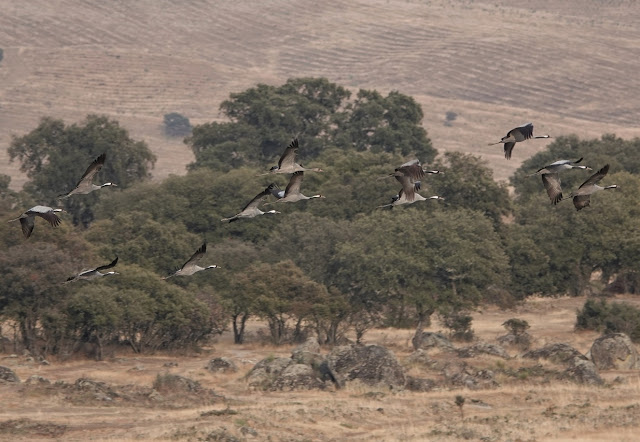They're back
 |
| Arrival of Common Cranes (Martin Kelsey) |
Yesterday as evening approached, I stood beside the Alcollarín Reservoir, near home. The sky was cloudless and the air still. Black-headed Gulls caught the low sunshine like reflective snow as they started to gather on the mirror-smooth surface of the lake. They mingled with Great Crested Grebes, which rolled to flash their white bellies and with the more sombre, pensive Black-necked Grebes. Beyond, near the far shore and in shallower water, a flotilla of Shoveler shuffled in vortex.
I was there to watch the gulls. but within minutes I swung to look southwards to determine the source of an unmistakeable bugling sound. It provides the wash to all winter soundscapes here. They heralded my first Common Cranes of the season. For days now, with persistently favourable weather conditions I have been especially tuned-in to pick up this sound, but to no avail. This has been the latest arrival of the "ladies in grey" as cranes are sometimes referred to here (the noun "grulla" is feminine) that I can recall. But there they were: a braided line flying low in my direction, about 45 in total. Another was following on behind, this time of at least seventy birds.
They flew against the backdrop of dehesa. Shadows from stolid holm oaks spread across the still flaxen withered herbs and grasses. It is testament to the depth and duration of the drought that the cranes have entered this year a land barely showing signs of autumnal renewal. The river beds are dry, pools are shrunken and the needle-like spears of grass shoots only just poised to flush the landscape green.
 |
| Cranes descending to roost (Martin Kelsey) |
The lines of cranes turned and pitched, their form opening into a cascading cloud, legs akimbo and angled wings as they dropped height. They landed with little bounces, steadied by their wings to recover their poise and accompanied by trumpeted greetings. On the shore of the reservoir they spread out and busied themselves to their own devices. Some strode to the water's edge to drink. Others made perfunctory pecks to the ground, others preened. From my vantage point, hidden amongst the trees, I could count each one as they arrived Over 475 come in before I had to quietly withdraw. Amongst them was a bird bearing colour-rings. As I watched it, I checked the internet on my mobile for the colour codes used for marked birds and could thus ascertain on the spot, that this was a bird from Estonia.
Today dawned damp. A thin seeeep overhead signaled a migrating Redwing. I stood at the same spot as 14 hours earlier. It was mild and the combination of the mist with the remnants of smoke from the illegal stubble-burning on the rice fields about 15 kilometres away gave a fug to the air, which immediately made me recall being out winter birding on the plains of North India. The roosting cranes had already departed for foraging areas out on maize stubble fields. Only a group of thirty remained, mooching about in the straggly pasture. I watched as they too took off, linked like a gentle, sagging chain on a westward course.



Comments